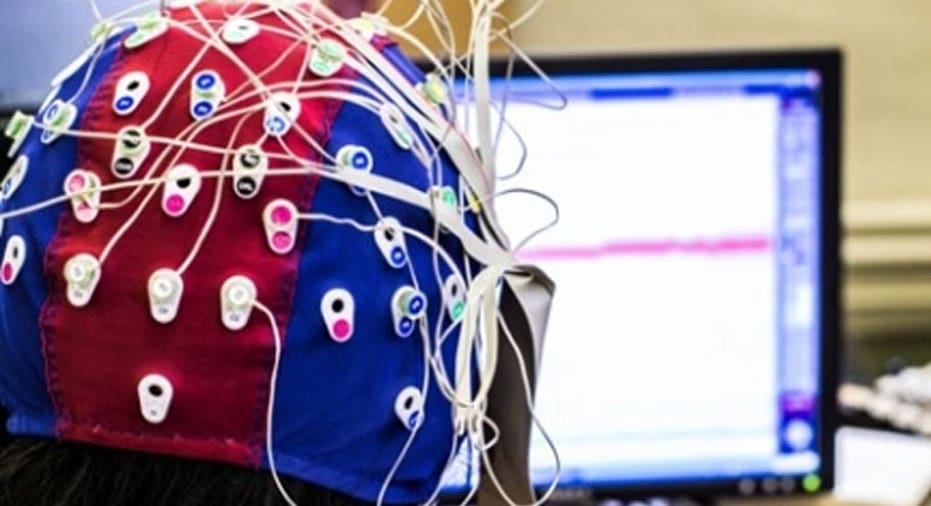For Brands, A Mind Is A Terrible Thing To Waste

Marketing has steadily evolved toward more precise and scientific methods. Focus groups and surveys are bowing to crowdsourcing and social listening, while manual data collection is fading in favor of big data and sophisticated analytics.
But somewhere between all of the data collection, number-crunching, and magical algorithms lies another, less obvious, marketing tool: neuroscience.
Simply put, neuroscience detects how the brain and body respond to messages. The concept is based on the study of sensorimotor, cognitive, and affective response to stimuli. It uses equipment, electrodes and sensors, and biometrics that measure heart rate, skin response, or eye movement--to understand how a person reacts to images, audio, and other sensory information. So-called neuromarketing is already used by a number of companies, including CBS (NYSE:CBS), Coca-Cola (NYSE:KO), Frito-Lay (NYSE:PEP), Google (NASDAQ:GOOGL), Hyundai, Microsoft (NASDAQ:MSFT), and PayPal (NASDAQ:EBAY)
Neuromarketing is based on the premise that much mental activity occurs at a subconscious or unconscious level, and people often don't know exactly what they are feeling or why they're thinking a certain way. "There's a recognition that people are primarily intuitive and emotional decison makers," observed Dan Hill, president of neuromarketing research firm Sensory Logic and author of “About Face: Ten Secrets to Emotionally Effective Advertising” (Kogan Page Publishing, 2010). "The ability to recognize responses and use them to guide marketing has the potential to produce dramatically better results."
But navigating the space is anything but easy. Not only is it crucial to apply neuromarketing methods effectively, it's also critical to understand how to plug in data and balance it with other input sources and marketing tools. Understandably, the concept isn't popular with everyone. Some describe neuromarketing as little more than a gimmick. A handful of consumer advocacy groups view it as invasive and manipulative. What's more, neuromarketing initiatives can run into the tens of thousands of dollars. "Neuromarketing is still taking shape," Hill told CMO.com.
Minding Business The idea of marketers tapping the subconscious mind isn't new. Vance Packard's 1957 bestseller, “The Hidden Persuaders,” offered compelling insights into the inner workings of the mind. During the next few decades, psychologists and researchers began to better understand the connections between the conscious, subconscious, and unconscious mind. Then, in 2002, Ale Smidts, a professor of marketing research at the Rotterdam School of Management at Erasmus University, coined the term "neuromarketing." It was based on the idea that observation, typically using sensors and tracking devices, could provide valid insights into thinking, emotions, and behavior that would otherwise fly below the radar.
To be sure, neuroscience adds a high-tech and high-touch spin to a sophisticated but very low-tech organ: the brain. "Neuromarketing offers a more robust picture of how consumers engage with marketing and product materials. It provides insights that otherwise aren't available," said Michael E. Smith, director of industry relations for the Consumer Neuroscience Branch at Nielson. Smith told CMO.com that he believes the concept is now in the "takeoff" phase and is on the way toward becoming "serious business."
In fact, he describes the movement toward a more scientific approach as Marketing 3.0. "We are seeing enormous progress…there is a growing recognition of the value of using neuromarketing," he stated.
Although the concept touches virtually every industry, product manufacturers have been among the most eager to embrace neuroscience. Campbell's Soup, Gerber, and Frito-Lay have turned to neuromarketing to redesign packaging and understand more about products. By showing consumers pieces of labeling and packaging and introducing additional components, it is possible to gauge positive, neutral, and negative responses. When marketers combine the data with in-depth interviews about specific issues and components, it's possible to gain deeper insights into the use of colors, text size, imagery, and the overall graphic layout.
For example, Frito-Lay discovered that shiny bags with pictures of chips elicited a negative response, while the same images on matte bags lead to a more positive view. In addition, images of healthful ingredients on a package did nothing to trigger behavior associated with buying. Consequently, the company introduced a new bag design with pictures of the chips frying. Meanwhile, a neuromarketing initiative at Hyundai Motor America in 2011 asked 15 men and 15 women to stare at different parts of a sporty vehicle, including the bumpers, windshield, and wheels. That helped Hyundai better understand what consumers pay attention to and what the auto company should focus on in terms of both design and marketing.
Political candidates, government, and not-for-profits have also turned to neuromarketing. For instance, when the organization Feeding America teamed with the Ad Council to develop a series of public service announcements designed to raise awareness about millions of hungry children in the U.S., they turned to Nielsen's consumer neuroscience practice to gain detailed insights into what resonates with viewers. Using neuroscience, they identified the moments and specific narratives that were most engaging. That helped Feeding America and the Ad Council select the phrasing and imagery that would best drive contributions.
For example, in one instance Feeding America developed a campaign around the concept of “food angels” who could help feed hungry children. "We tested two versions of the ad: One image had food bank volunteers with animated angel wings, and the other showed them without wings," said Stephanie Rath, director of marketing at Feeding Americ, in an interview with CMO.com. The organization found that the wings attracted more attention and drove higher memory retention for the organization.
More From CMO.com
4 Reasons Why CMO Tenure Will Continue To IncreaseFailure To Launch? 6 Steps To Get Your Product Off The Ground3 Lessons CMOs Can Learn From Growth HackersWho Needs Sleep When You're A CMO?



















